Contemporary Policy Analysis: Teenage Pregnancy and Public Health
VerifiedAdded on 2023/01/18
|8
|2273
|50
Report
AI Summary
This report provides a comprehensive analysis of the contemporary policy related to teenage pregnancy in the UK. It begins with background information on the UK's teenage pregnancy strategy, highlighting the issue's significance as a public health concern. The report then delves into a detailed description of the policy, including its objectives, implementation, and the four key themes designed to reduce adolescent parenthood. It examines the policy's impact on society, including education, healthcare and the role of health services staff, and its role in the healthcare sector. The analysis covers the impact of the policy on various stakeholders, including teenagers, families, and healthcare providers, and discusses the roles of the UK Labour government, the World Health Organization, and Public Health England in supporting and implementing the strategy. The report concludes by summarizing the effectiveness of the policy in reducing teenage pregnancy rates and improving overall public health outcomes, emphasizing the importance of continued efforts to address this critical social issue. The report highlights the importance of data collection, monitoring, and collaboration between local and national authorities, and the role of education and awareness campaigns in preventing teenage pregnancies. Finally, the report considers the impact of the policy on health services staff, including the training and practices they employ to support teenage mothers.
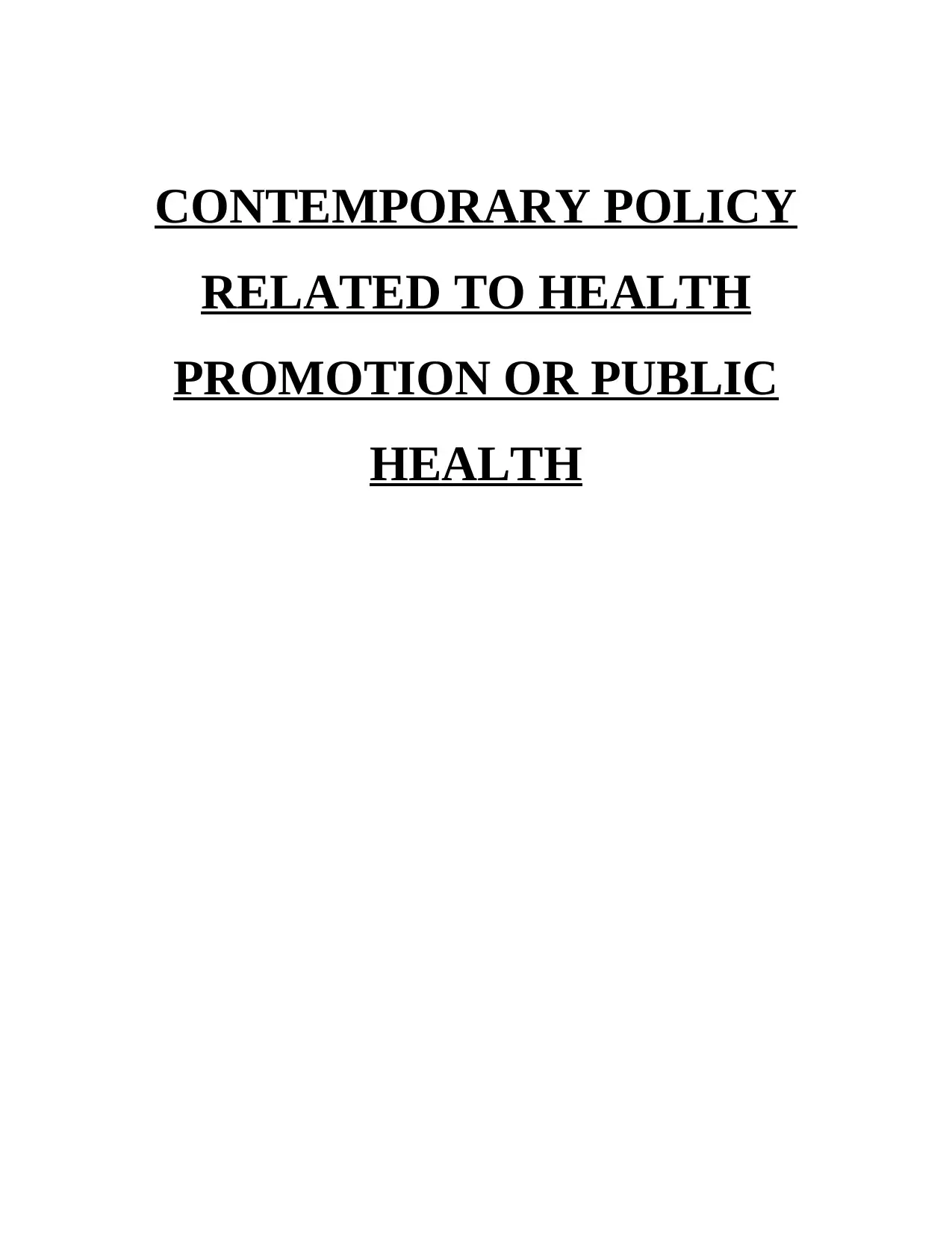
CONTEMPORARY POLICY
RELATED TO HEALTH
PROMOTION OR PUBLIC
HEALTH
RELATED TO HEALTH
PROMOTION OR PUBLIC
HEALTH
Paraphrase This Document
Need a fresh take? Get an instant paraphrase of this document with our AI Paraphraser
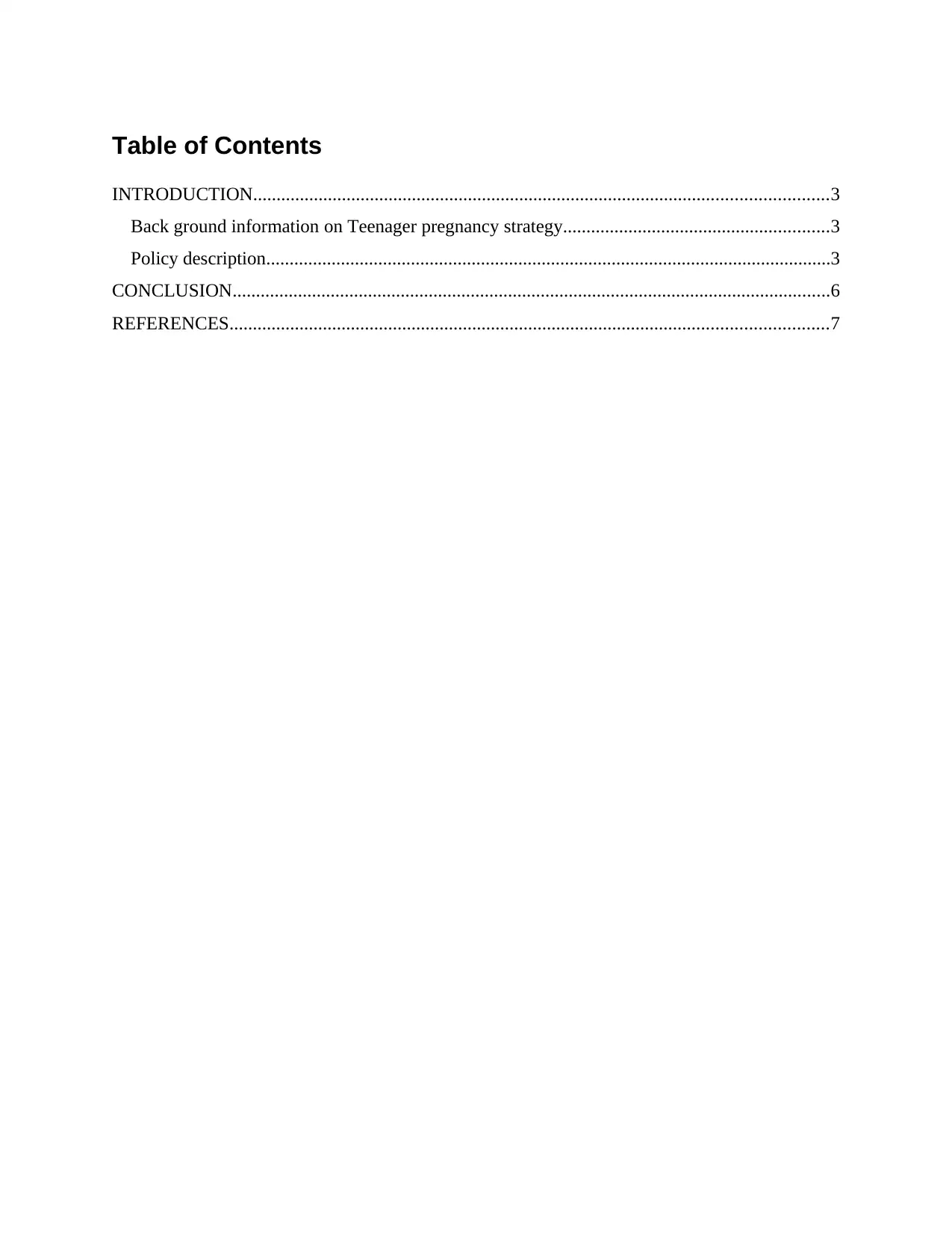
Table of Contents
INTRODUCTION...........................................................................................................................3
Back ground information on Teenager pregnancy strategy.........................................................3
Policy description.........................................................................................................................3
CONCLUSION................................................................................................................................6
REFERENCES................................................................................................................................7
INTRODUCTION...........................................................................................................................3
Back ground information on Teenager pregnancy strategy.........................................................3
Policy description.........................................................................................................................3
CONCLUSION................................................................................................................................6
REFERENCES................................................................................................................................7
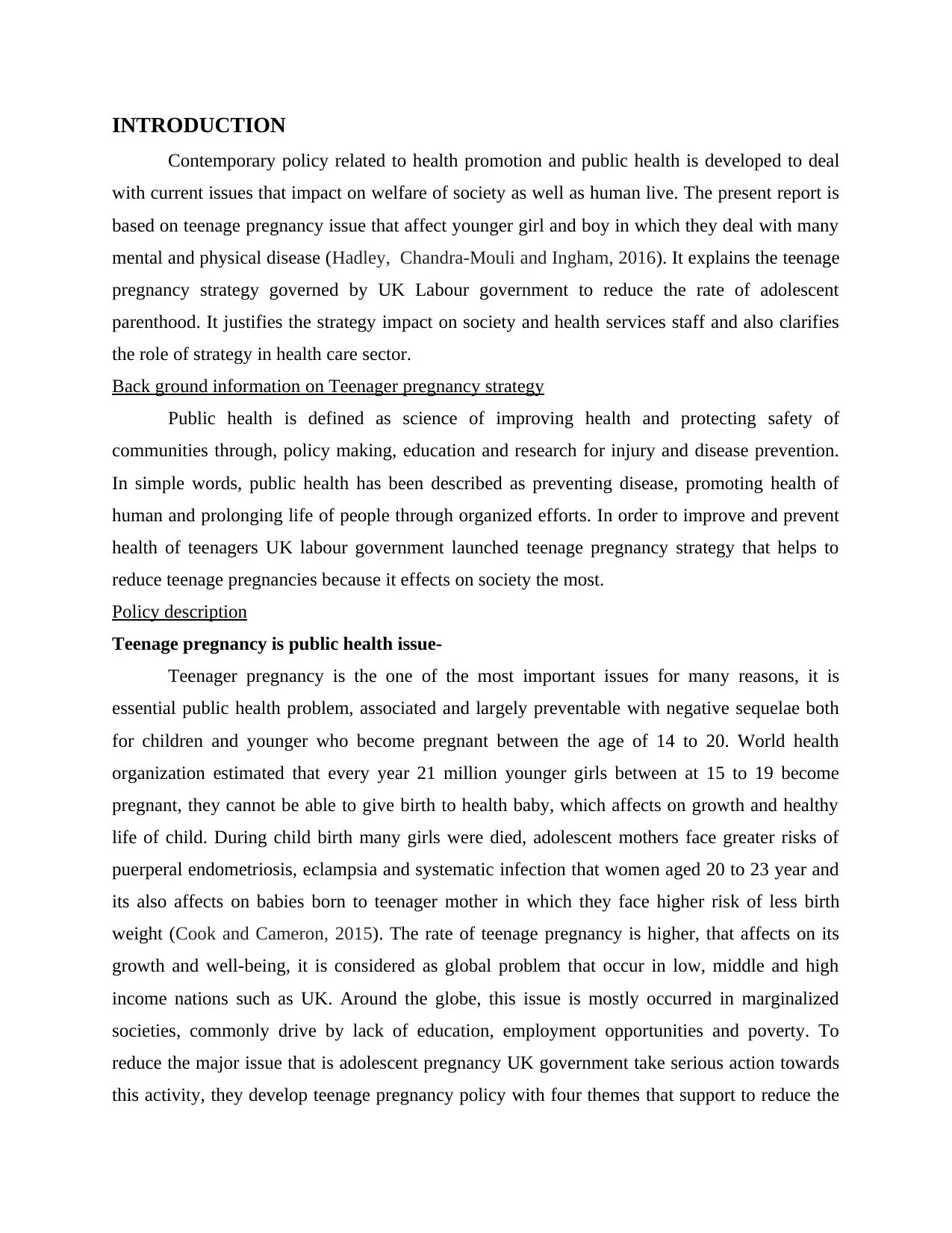
INTRODUCTION
Contemporary policy related to health promotion and public health is developed to deal
with current issues that impact on welfare of society as well as human live. The present report is
based on teenage pregnancy issue that affect younger girl and boy in which they deal with many
mental and physical disease (Hadley, Chandra-Mouli and Ingham, 2016). It explains the teenage
pregnancy strategy governed by UK Labour government to reduce the rate of adolescent
parenthood. It justifies the strategy impact on society and health services staff and also clarifies
the role of strategy in health care sector.
Back ground information on Teenager pregnancy strategy
Public health is defined as science of improving health and protecting safety of
communities through, policy making, education and research for injury and disease prevention.
In simple words, public health has been described as preventing disease, promoting health of
human and prolonging life of people through organized efforts. In order to improve and prevent
health of teenagers UK labour government launched teenage pregnancy strategy that helps to
reduce teenage pregnancies because it effects on society the most.
Policy description
Teenage pregnancy is public health issue-
Teenager pregnancy is the one of the most important issues for many reasons, it is
essential public health problem, associated and largely preventable with negative sequelae both
for children and younger who become pregnant between the age of 14 to 20. World health
organization estimated that every year 21 million younger girls between at 15 to 19 become
pregnant, they cannot be able to give birth to health baby, which affects on growth and healthy
life of child. During child birth many girls were died, adolescent mothers face greater risks of
puerperal endometriosis, eclampsia and systematic infection that women aged 20 to 23 year and
its also affects on babies born to teenager mother in which they face higher risk of less birth
weight (Cook and Cameron, 2015). The rate of teenage pregnancy is higher, that affects on its
growth and well-being, it is considered as global problem that occur in low, middle and high
income nations such as UK. Around the globe, this issue is mostly occurred in marginalized
societies, commonly drive by lack of education, employment opportunities and poverty. To
reduce the major issue that is adolescent pregnancy UK government take serious action towards
this activity, they develop teenage pregnancy policy with four themes that support to reduce the
Contemporary policy related to health promotion and public health is developed to deal
with current issues that impact on welfare of society as well as human live. The present report is
based on teenage pregnancy issue that affect younger girl and boy in which they deal with many
mental and physical disease (Hadley, Chandra-Mouli and Ingham, 2016). It explains the teenage
pregnancy strategy governed by UK Labour government to reduce the rate of adolescent
parenthood. It justifies the strategy impact on society and health services staff and also clarifies
the role of strategy in health care sector.
Back ground information on Teenager pregnancy strategy
Public health is defined as science of improving health and protecting safety of
communities through, policy making, education and research for injury and disease prevention.
In simple words, public health has been described as preventing disease, promoting health of
human and prolonging life of people through organized efforts. In order to improve and prevent
health of teenagers UK labour government launched teenage pregnancy strategy that helps to
reduce teenage pregnancies because it effects on society the most.
Policy description
Teenage pregnancy is public health issue-
Teenager pregnancy is the one of the most important issues for many reasons, it is
essential public health problem, associated and largely preventable with negative sequelae both
for children and younger who become pregnant between the age of 14 to 20. World health
organization estimated that every year 21 million younger girls between at 15 to 19 become
pregnant, they cannot be able to give birth to health baby, which affects on growth and healthy
life of child. During child birth many girls were died, adolescent mothers face greater risks of
puerperal endometriosis, eclampsia and systematic infection that women aged 20 to 23 year and
its also affects on babies born to teenager mother in which they face higher risk of less birth
weight (Cook and Cameron, 2015). The rate of teenage pregnancy is higher, that affects on its
growth and well-being, it is considered as global problem that occur in low, middle and high
income nations such as UK. Around the globe, this issue is mostly occurred in marginalized
societies, commonly drive by lack of education, employment opportunities and poverty. To
reduce the major issue that is adolescent pregnancy UK government take serious action towards
this activity, they develop teenage pregnancy policy with four themes that support to reduce the
⊘ This is a preview!⊘
Do you want full access?
Subscribe today to unlock all pages.

Trusted by 1+ million students worldwide
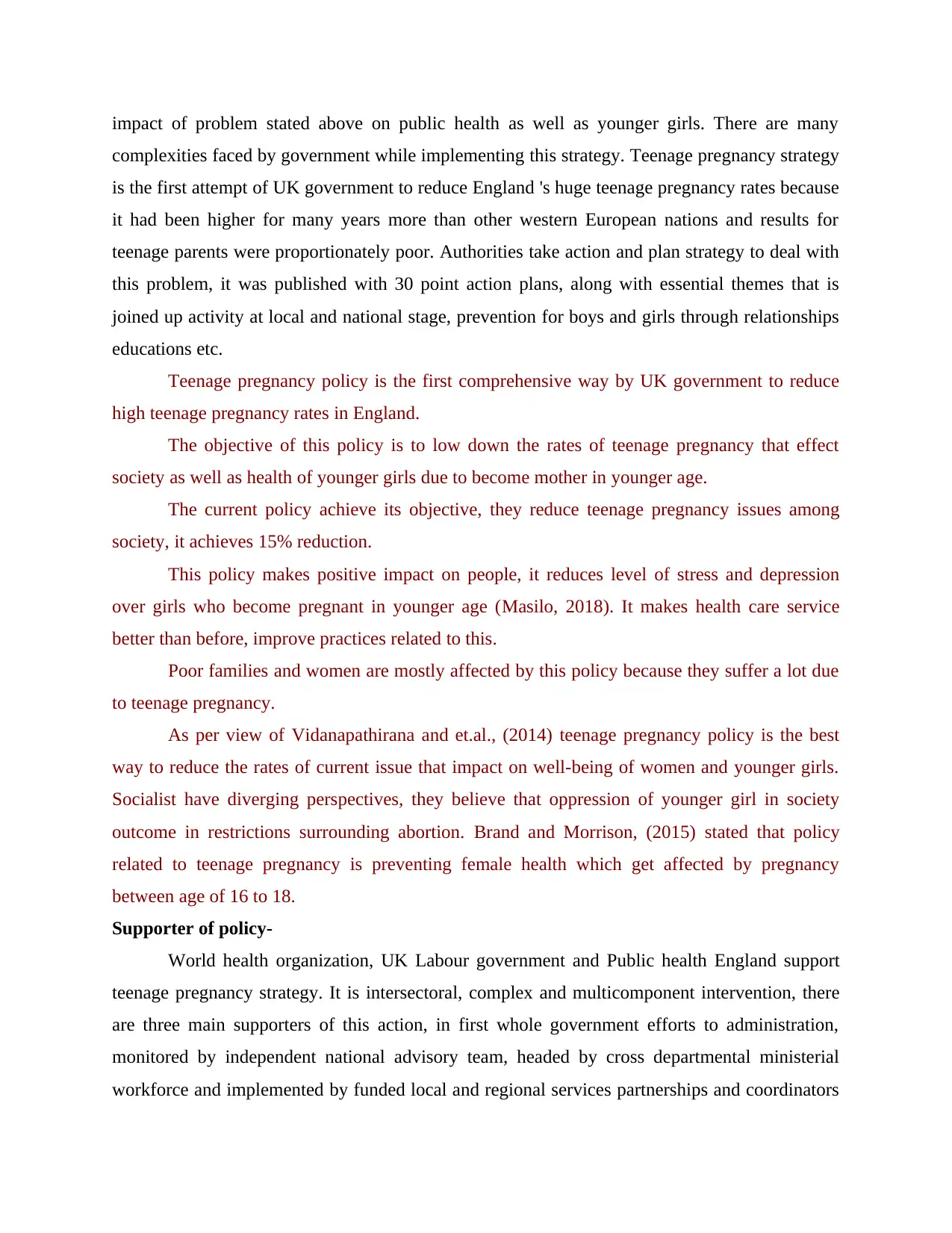
impact of problem stated above on public health as well as younger girls. There are many
complexities faced by government while implementing this strategy. Teenage pregnancy strategy
is the first attempt of UK government to reduce England 's huge teenage pregnancy rates because
it had been higher for many years more than other western European nations and results for
teenage parents were proportionately poor. Authorities take action and plan strategy to deal with
this problem, it was published with 30 point action plans, along with essential themes that is
joined up activity at local and national stage, prevention for boys and girls through relationships
educations etc.
Teenage pregnancy policy is the first comprehensive way by UK government to reduce
high teenage pregnancy rates in England.
The objective of this policy is to low down the rates of teenage pregnancy that effect
society as well as health of younger girls due to become mother in younger age.
The current policy achieve its objective, they reduce teenage pregnancy issues among
society, it achieves 15% reduction.
This policy makes positive impact on people, it reduces level of stress and depression
over girls who become pregnant in younger age (Masilo, 2018). It makes health care service
better than before, improve practices related to this.
Poor families and women are mostly affected by this policy because they suffer a lot due
to teenage pregnancy.
As per view of Vidanapathirana and et.al., (2014) teenage pregnancy policy is the best
way to reduce the rates of current issue that impact on well-being of women and younger girls.
Socialist have diverging perspectives, they believe that oppression of younger girl in society
outcome in restrictions surrounding abortion. Brand and Morrison, (2015) stated that policy
related to teenage pregnancy is preventing female health which get affected by pregnancy
between age of 16 to 18.
Supporter of policy-
World health organization, UK Labour government and Public health England support
teenage pregnancy strategy. It is intersectoral, complex and multicomponent intervention, there
are three main supporters of this action, in first whole government efforts to administration,
monitored by independent national advisory team, headed by cross departmental ministerial
workforce and implemented by funded local and regional services partnerships and coordinators
complexities faced by government while implementing this strategy. Teenage pregnancy strategy
is the first attempt of UK government to reduce England 's huge teenage pregnancy rates because
it had been higher for many years more than other western European nations and results for
teenage parents were proportionately poor. Authorities take action and plan strategy to deal with
this problem, it was published with 30 point action plans, along with essential themes that is
joined up activity at local and national stage, prevention for boys and girls through relationships
educations etc.
Teenage pregnancy policy is the first comprehensive way by UK government to reduce
high teenage pregnancy rates in England.
The objective of this policy is to low down the rates of teenage pregnancy that effect
society as well as health of younger girls due to become mother in younger age.
The current policy achieve its objective, they reduce teenage pregnancy issues among
society, it achieves 15% reduction.
This policy makes positive impact on people, it reduces level of stress and depression
over girls who become pregnant in younger age (Masilo, 2018). It makes health care service
better than before, improve practices related to this.
Poor families and women are mostly affected by this policy because they suffer a lot due
to teenage pregnancy.
As per view of Vidanapathirana and et.al., (2014) teenage pregnancy policy is the best
way to reduce the rates of current issue that impact on well-being of women and younger girls.
Socialist have diverging perspectives, they believe that oppression of younger girl in society
outcome in restrictions surrounding abortion. Brand and Morrison, (2015) stated that policy
related to teenage pregnancy is preventing female health which get affected by pregnancy
between age of 16 to 18.
Supporter of policy-
World health organization, UK Labour government and Public health England support
teenage pregnancy strategy. It is intersectoral, complex and multicomponent intervention, there
are three main supporters of this action, in first whole government efforts to administration,
monitored by independent national advisory team, headed by cross departmental ministerial
workforce and implemented by funded local and regional services partnerships and coordinators
Paraphrase This Document
Need a fresh take? Get an instant paraphrase of this document with our AI Paraphraser
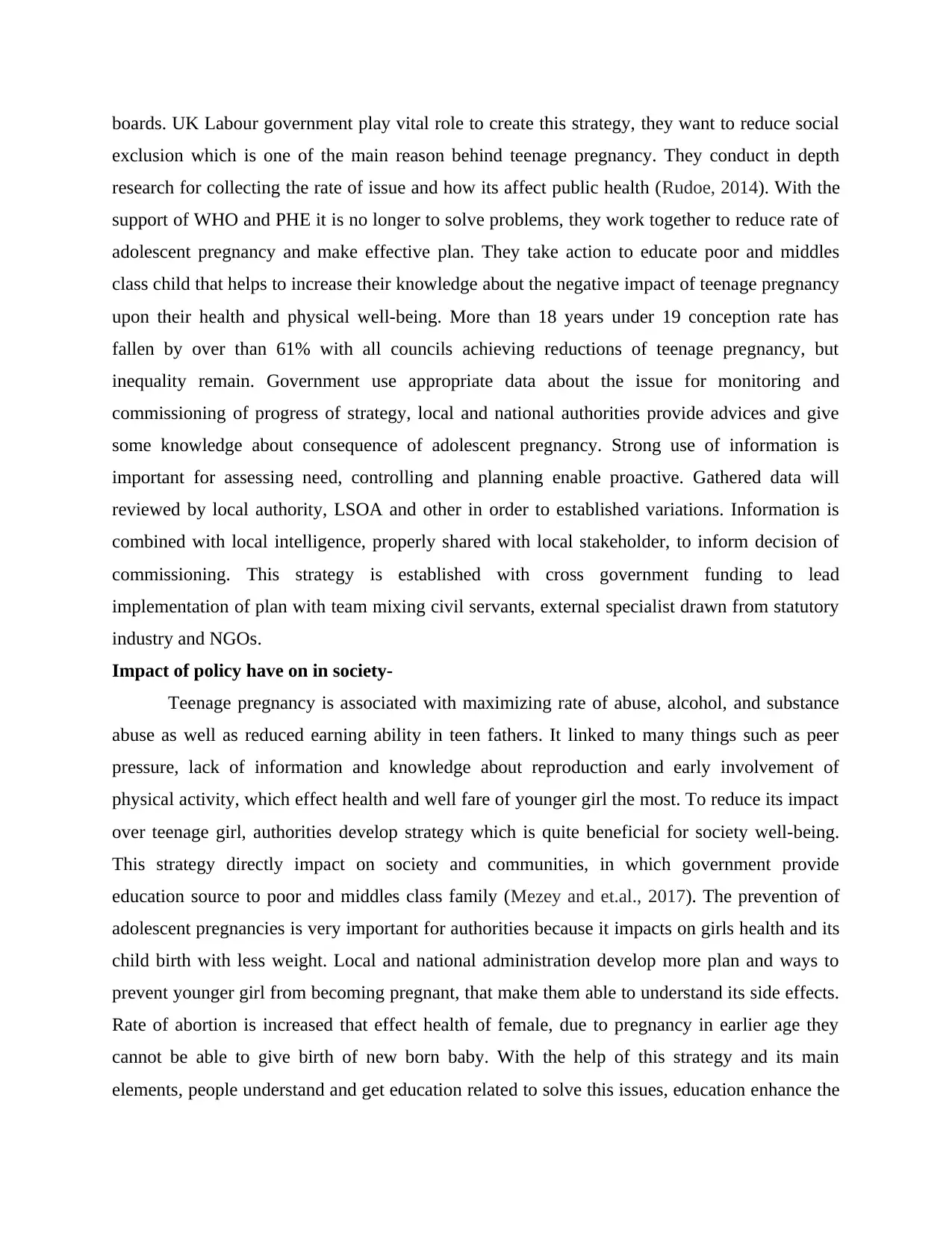
boards. UK Labour government play vital role to create this strategy, they want to reduce social
exclusion which is one of the main reason behind teenage pregnancy. They conduct in depth
research for collecting the rate of issue and how its affect public health (Rudoe, 2014). With the
support of WHO and PHE it is no longer to solve problems, they work together to reduce rate of
adolescent pregnancy and make effective plan. They take action to educate poor and middles
class child that helps to increase their knowledge about the negative impact of teenage pregnancy
upon their health and physical well-being. More than 18 years under 19 conception rate has
fallen by over than 61% with all councils achieving reductions of teenage pregnancy, but
inequality remain. Government use appropriate data about the issue for monitoring and
commissioning of progress of strategy, local and national authorities provide advices and give
some knowledge about consequence of adolescent pregnancy. Strong use of information is
important for assessing need, controlling and planning enable proactive. Gathered data will
reviewed by local authority, LSOA and other in order to established variations. Information is
combined with local intelligence, properly shared with local stakeholder, to inform decision of
commissioning. This strategy is established with cross government funding to lead
implementation of plan with team mixing civil servants, external specialist drawn from statutory
industry and NGOs.
Impact of policy have on in society-
Teenage pregnancy is associated with maximizing rate of abuse, alcohol, and substance
abuse as well as reduced earning ability in teen fathers. It linked to many things such as peer
pressure, lack of information and knowledge about reproduction and early involvement of
physical activity, which effect health and well fare of younger girl the most. To reduce its impact
over teenage girl, authorities develop strategy which is quite beneficial for society well-being.
This strategy directly impact on society and communities, in which government provide
education source to poor and middles class family (Mezey and et.al., 2017). The prevention of
adolescent pregnancies is very important for authorities because it impacts on girls health and its
child birth with less weight. Local and national administration develop more plan and ways to
prevent younger girl from becoming pregnant, that make them able to understand its side effects.
Rate of abortion is increased that effect health of female, due to pregnancy in earlier age they
cannot be able to give birth of new born baby. With the help of this strategy and its main
elements, people understand and get education related to solve this issues, education enhance the
exclusion which is one of the main reason behind teenage pregnancy. They conduct in depth
research for collecting the rate of issue and how its affect public health (Rudoe, 2014). With the
support of WHO and PHE it is no longer to solve problems, they work together to reduce rate of
adolescent pregnancy and make effective plan. They take action to educate poor and middles
class child that helps to increase their knowledge about the negative impact of teenage pregnancy
upon their health and physical well-being. More than 18 years under 19 conception rate has
fallen by over than 61% with all councils achieving reductions of teenage pregnancy, but
inequality remain. Government use appropriate data about the issue for monitoring and
commissioning of progress of strategy, local and national authorities provide advices and give
some knowledge about consequence of adolescent pregnancy. Strong use of information is
important for assessing need, controlling and planning enable proactive. Gathered data will
reviewed by local authority, LSOA and other in order to established variations. Information is
combined with local intelligence, properly shared with local stakeholder, to inform decision of
commissioning. This strategy is established with cross government funding to lead
implementation of plan with team mixing civil servants, external specialist drawn from statutory
industry and NGOs.
Impact of policy have on in society-
Teenage pregnancy is associated with maximizing rate of abuse, alcohol, and substance
abuse as well as reduced earning ability in teen fathers. It linked to many things such as peer
pressure, lack of information and knowledge about reproduction and early involvement of
physical activity, which effect health and well fare of younger girl the most. To reduce its impact
over teenage girl, authorities develop strategy which is quite beneficial for society well-being.
This strategy directly impact on society and communities, in which government provide
education source to poor and middles class family (Mezey and et.al., 2017). The prevention of
adolescent pregnancies is very important for authorities because it impacts on girls health and its
child birth with less weight. Local and national administration develop more plan and ways to
prevent younger girl from becoming pregnant, that make them able to understand its side effects.
Rate of abortion is increased that effect health of female, due to pregnancy in earlier age they
cannot be able to give birth of new born baby. With the help of this strategy and its main
elements, people understand and get education related to solve this issues, education enhance the
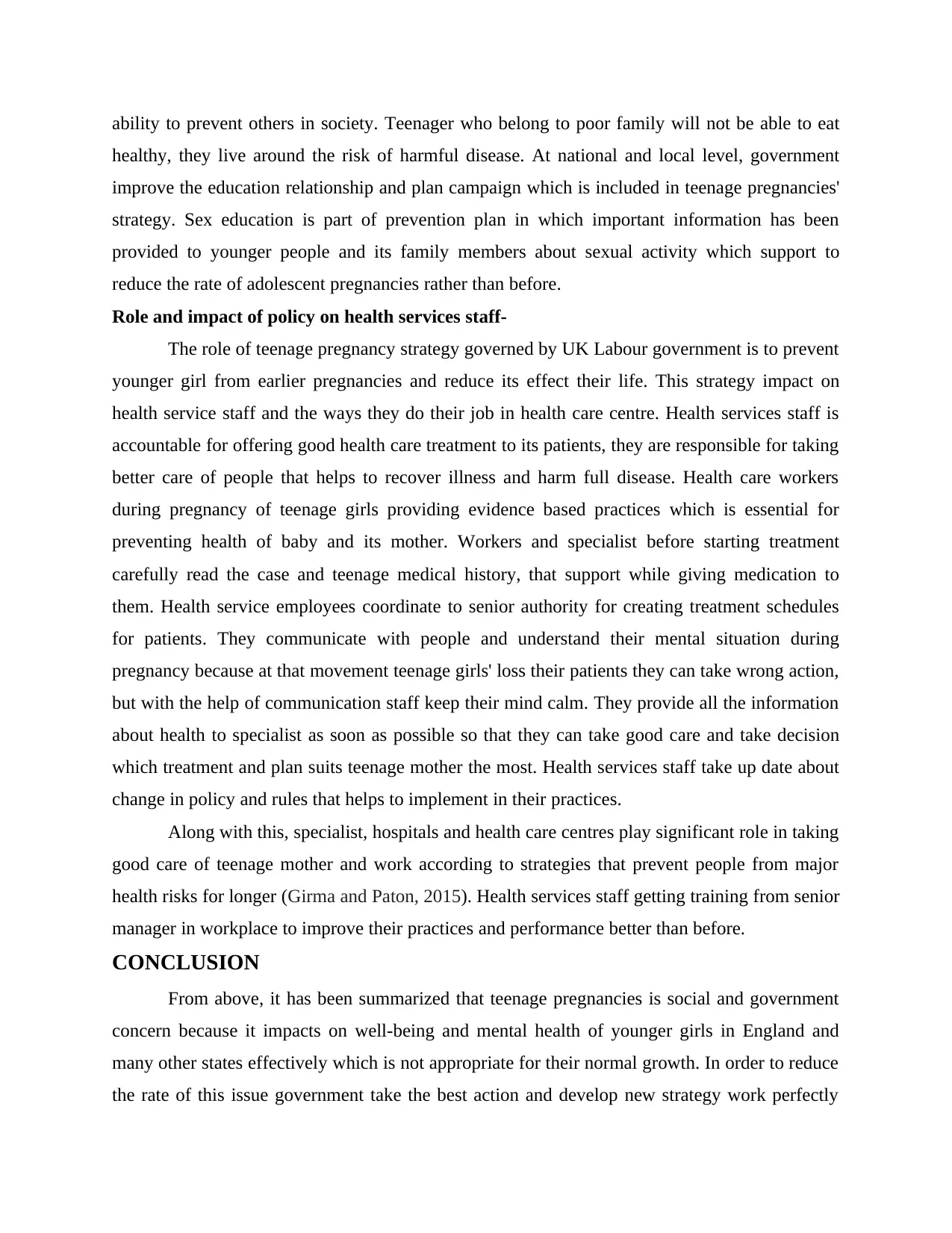
ability to prevent others in society. Teenager who belong to poor family will not be able to eat
healthy, they live around the risk of harmful disease. At national and local level, government
improve the education relationship and plan campaign which is included in teenage pregnancies'
strategy. Sex education is part of prevention plan in which important information has been
provided to younger people and its family members about sexual activity which support to
reduce the rate of adolescent pregnancies rather than before.
Role and impact of policy on health services staff-
The role of teenage pregnancy strategy governed by UK Labour government is to prevent
younger girl from earlier pregnancies and reduce its effect their life. This strategy impact on
health service staff and the ways they do their job in health care centre. Health services staff is
accountable for offering good health care treatment to its patients, they are responsible for taking
better care of people that helps to recover illness and harm full disease. Health care workers
during pregnancy of teenage girls providing evidence based practices which is essential for
preventing health of baby and its mother. Workers and specialist before starting treatment
carefully read the case and teenage medical history, that support while giving medication to
them. Health service employees coordinate to senior authority for creating treatment schedules
for patients. They communicate with people and understand their mental situation during
pregnancy because at that movement teenage girls' loss their patients they can take wrong action,
but with the help of communication staff keep their mind calm. They provide all the information
about health to specialist as soon as possible so that they can take good care and take decision
which treatment and plan suits teenage mother the most. Health services staff take up date about
change in policy and rules that helps to implement in their practices.
Along with this, specialist, hospitals and health care centres play significant role in taking
good care of teenage mother and work according to strategies that prevent people from major
health risks for longer (Girma and Paton, 2015). Health services staff getting training from senior
manager in workplace to improve their practices and performance better than before.
CONCLUSION
From above, it has been summarized that teenage pregnancies is social and government
concern because it impacts on well-being and mental health of younger girls in England and
many other states effectively which is not appropriate for their normal growth. In order to reduce
the rate of this issue government take the best action and develop new strategy work perfectly
healthy, they live around the risk of harmful disease. At national and local level, government
improve the education relationship and plan campaign which is included in teenage pregnancies'
strategy. Sex education is part of prevention plan in which important information has been
provided to younger people and its family members about sexual activity which support to
reduce the rate of adolescent pregnancies rather than before.
Role and impact of policy on health services staff-
The role of teenage pregnancy strategy governed by UK Labour government is to prevent
younger girl from earlier pregnancies and reduce its effect their life. This strategy impact on
health service staff and the ways they do their job in health care centre. Health services staff is
accountable for offering good health care treatment to its patients, they are responsible for taking
better care of people that helps to recover illness and harm full disease. Health care workers
during pregnancy of teenage girls providing evidence based practices which is essential for
preventing health of baby and its mother. Workers and specialist before starting treatment
carefully read the case and teenage medical history, that support while giving medication to
them. Health service employees coordinate to senior authority for creating treatment schedules
for patients. They communicate with people and understand their mental situation during
pregnancy because at that movement teenage girls' loss their patients they can take wrong action,
but with the help of communication staff keep their mind calm. They provide all the information
about health to specialist as soon as possible so that they can take good care and take decision
which treatment and plan suits teenage mother the most. Health services staff take up date about
change in policy and rules that helps to implement in their practices.
Along with this, specialist, hospitals and health care centres play significant role in taking
good care of teenage mother and work according to strategies that prevent people from major
health risks for longer (Girma and Paton, 2015). Health services staff getting training from senior
manager in workplace to improve their practices and performance better than before.
CONCLUSION
From above, it has been summarized that teenage pregnancies is social and government
concern because it impacts on well-being and mental health of younger girls in England and
many other states effectively which is not appropriate for their normal growth. In order to reduce
the rate of this issue government take the best action and develop new strategy work perfectly
⊘ This is a preview!⊘
Do you want full access?
Subscribe today to unlock all pages.

Trusted by 1+ million students worldwide
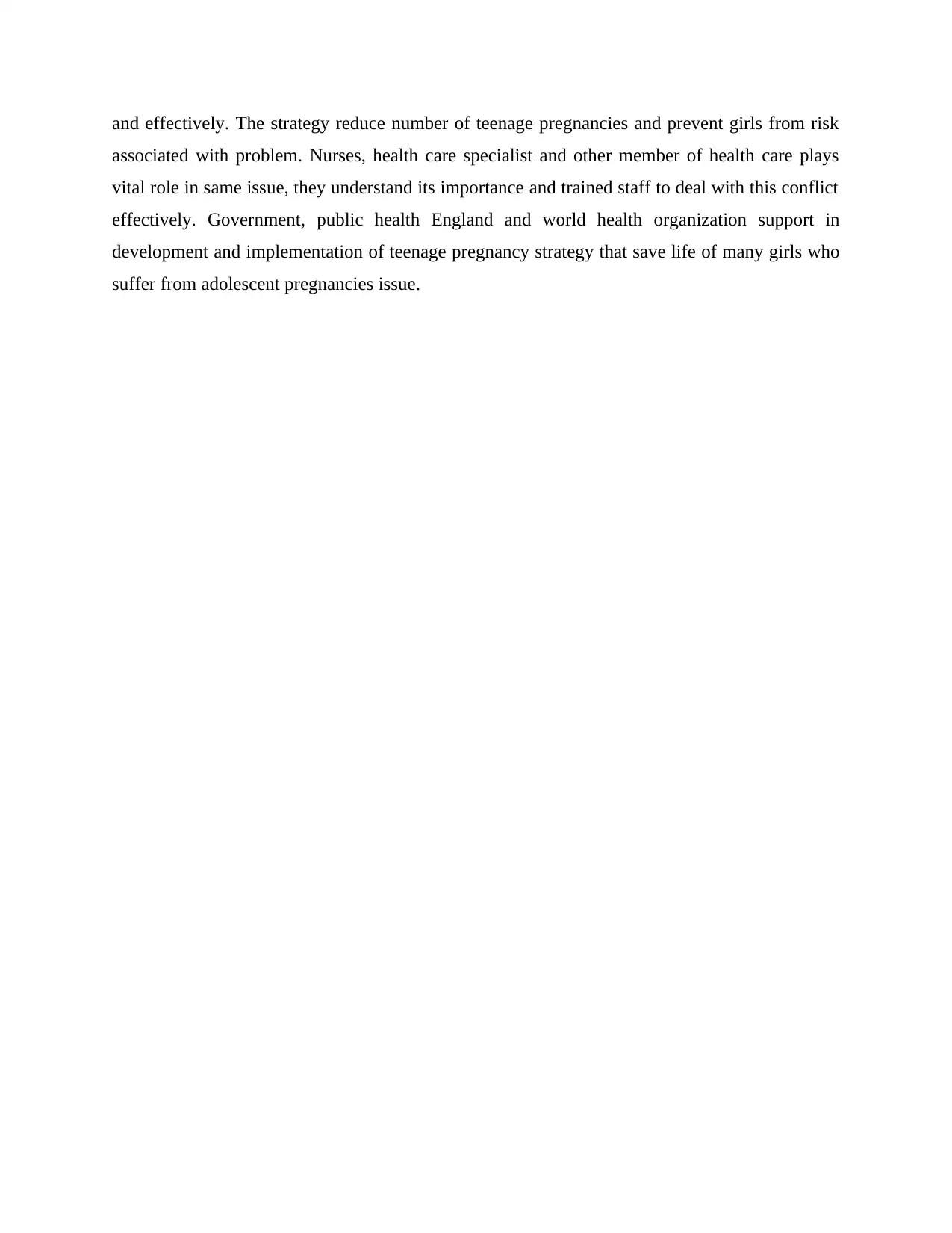
and effectively. The strategy reduce number of teenage pregnancies and prevent girls from risk
associated with problem. Nurses, health care specialist and other member of health care plays
vital role in same issue, they understand its importance and trained staff to deal with this conflict
effectively. Government, public health England and world health organization support in
development and implementation of teenage pregnancy strategy that save life of many girls who
suffer from adolescent pregnancies issue.
associated with problem. Nurses, health care specialist and other member of health care plays
vital role in same issue, they understand its importance and trained staff to deal with this conflict
effectively. Government, public health England and world health organization support in
development and implementation of teenage pregnancy strategy that save life of many girls who
suffer from adolescent pregnancies issue.
Paraphrase This Document
Need a fresh take? Get an instant paraphrase of this document with our AI Paraphraser
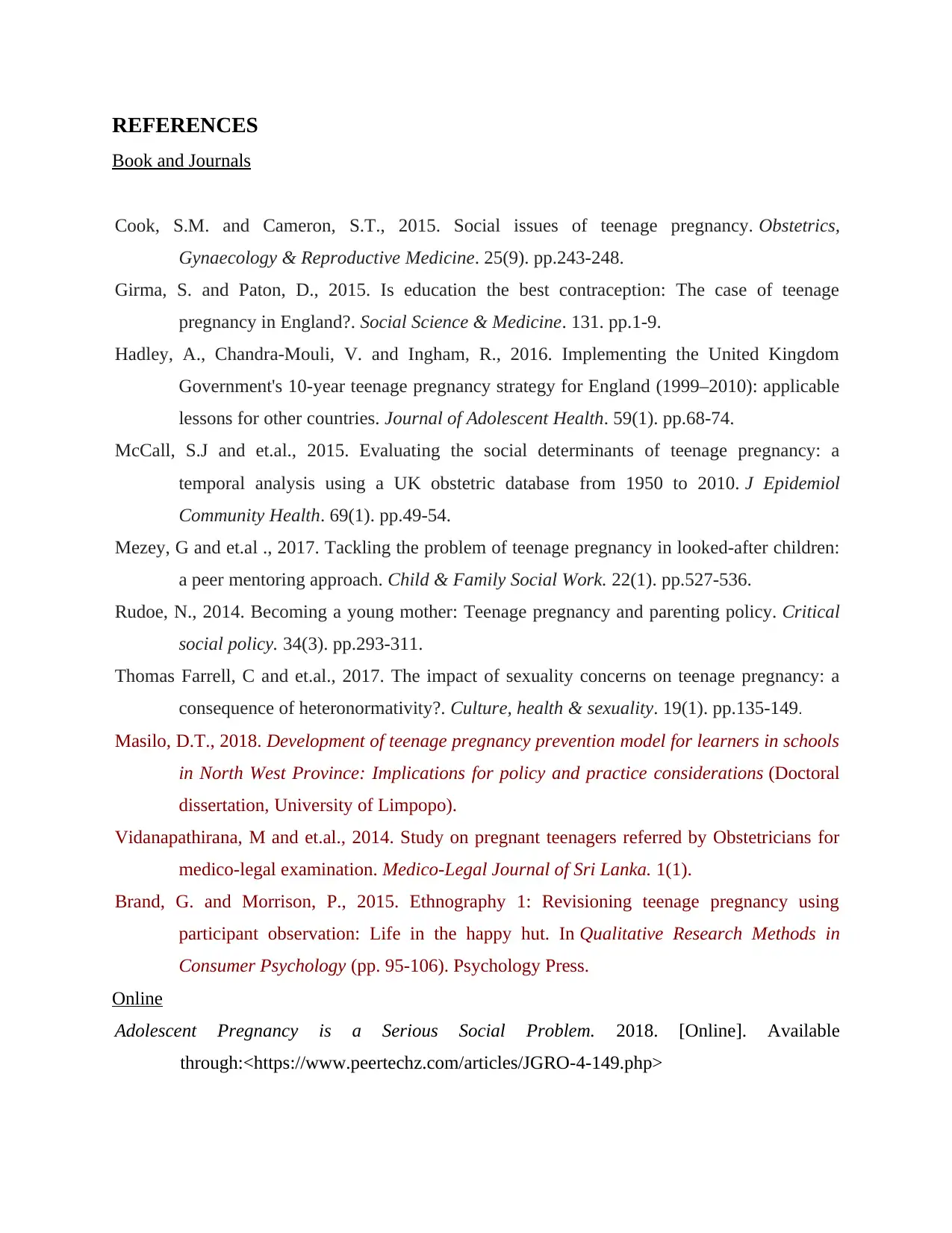
REFERENCES
Book and Journals
Cook, S.M. and Cameron, S.T., 2015. Social issues of teenage pregnancy. Obstetrics,
Gynaecology & Reproductive Medicine. 25(9). pp.243-248.
Girma, S. and Paton, D., 2015. Is education the best contraception: The case of teenage
pregnancy in England?. Social Science & Medicine. 131. pp.1-9.
Hadley, A., Chandra-Mouli, V. and Ingham, R., 2016. Implementing the United Kingdom
Government's 10-year teenage pregnancy strategy for England (1999–2010): applicable
lessons for other countries. Journal of Adolescent Health. 59(1). pp.68-74.
McCall, S.J and et.al., 2015. Evaluating the social determinants of teenage pregnancy: a
temporal analysis using a UK obstetric database from 1950 to 2010. J Epidemiol
Community Health. 69(1). pp.49-54.
Mezey, G and et.al ., 2017. Tackling the problem of teenage pregnancy in looked‐after children:
a peer mentoring approach. Child & Family Social Work. 22(1). pp.527-536.
Rudoe, N., 2014. Becoming a young mother: Teenage pregnancy and parenting policy. Critical
social policy. 34(3). pp.293-311.
Thomas Farrell, C and et.al., 2017. The impact of sexuality concerns on teenage pregnancy: a
consequence of heteronormativity?. Culture, health & sexuality. 19(1). pp.135-149.
Masilo, D.T., 2018. Development of teenage pregnancy prevention model for learners in schools
in North West Province: Implications for policy and practice considerations (Doctoral
dissertation, University of Limpopo).
Vidanapathirana, M and et.al., 2014. Study on pregnant teenagers referred by Obstetricians for
medico-legal examination. Medico-Legal Journal of Sri Lanka. 1(1).
Brand, G. and Morrison, P., 2015. Ethnography 1: Revisioning teenage pregnancy using
participant observation: Life in the happy hut. In Qualitative Research Methods in
Consumer Psychology (pp. 95-106). Psychology Press.
Online
Adolescent Pregnancy is a Serious Social Problem. 2018. [Online]. Available
through:<https://www.peertechz.com/articles/JGRO-4-149.php>
Book and Journals
Cook, S.M. and Cameron, S.T., 2015. Social issues of teenage pregnancy. Obstetrics,
Gynaecology & Reproductive Medicine. 25(9). pp.243-248.
Girma, S. and Paton, D., 2015. Is education the best contraception: The case of teenage
pregnancy in England?. Social Science & Medicine. 131. pp.1-9.
Hadley, A., Chandra-Mouli, V. and Ingham, R., 2016. Implementing the United Kingdom
Government's 10-year teenage pregnancy strategy for England (1999–2010): applicable
lessons for other countries. Journal of Adolescent Health. 59(1). pp.68-74.
McCall, S.J and et.al., 2015. Evaluating the social determinants of teenage pregnancy: a
temporal analysis using a UK obstetric database from 1950 to 2010. J Epidemiol
Community Health. 69(1). pp.49-54.
Mezey, G and et.al ., 2017. Tackling the problem of teenage pregnancy in looked‐after children:
a peer mentoring approach. Child & Family Social Work. 22(1). pp.527-536.
Rudoe, N., 2014. Becoming a young mother: Teenage pregnancy and parenting policy. Critical
social policy. 34(3). pp.293-311.
Thomas Farrell, C and et.al., 2017. The impact of sexuality concerns on teenage pregnancy: a
consequence of heteronormativity?. Culture, health & sexuality. 19(1). pp.135-149.
Masilo, D.T., 2018. Development of teenage pregnancy prevention model for learners in schools
in North West Province: Implications for policy and practice considerations (Doctoral
dissertation, University of Limpopo).
Vidanapathirana, M and et.al., 2014. Study on pregnant teenagers referred by Obstetricians for
medico-legal examination. Medico-Legal Journal of Sri Lanka. 1(1).
Brand, G. and Morrison, P., 2015. Ethnography 1: Revisioning teenage pregnancy using
participant observation: Life in the happy hut. In Qualitative Research Methods in
Consumer Psychology (pp. 95-106). Psychology Press.
Online
Adolescent Pregnancy is a Serious Social Problem. 2018. [Online]. Available
through:<https://www.peertechz.com/articles/JGRO-4-149.php>
1 out of 8
Related Documents
Your All-in-One AI-Powered Toolkit for Academic Success.
+13062052269
info@desklib.com
Available 24*7 on WhatsApp / Email
![[object Object]](/_next/static/media/star-bottom.7253800d.svg)
Unlock your academic potential
Copyright © 2020–2025 A2Z Services. All Rights Reserved. Developed and managed by ZUCOL.





